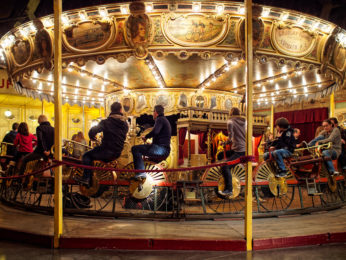
The carnival can also be a place of energy innovation. Before being an indispensable element for our bicycles, the pedalboard is democratized within an attraction: the bicycle ride. In 1861, the 19-year-old Ernest Michaux made repairs on a velocipede, a “running machine” in wood, without pedals and without brakes, with two wheels. He does not know where to put his feet during his use and therefore finds his handling to be very tiring. On the advice of his father, Pierre Michaux, he adds a crank and sets pedals to the wheel. The pedal is born, but is still too expensive. Its distribution is done during a carnival in 1869 in the United States. A new attraction, the velocipede ride, invites people to settle on a seat and pedal together to speed up the structure. By going up to 60 km / h, it exceeds the means of locomotion of the time which rarely reach more than 20 km / h. There are only two models of a velocipede ride, one of which is at the Musée des Arts Forains in Paris. It was manufactured in 1897 by Caillebaut and Decanck in Ghent, Belgium, from an English patent of the firm Savage. This small piece of museum reminds us that electricity or a oil engine is not necessary to experience thrills: muscular strength is sometimes enough!



